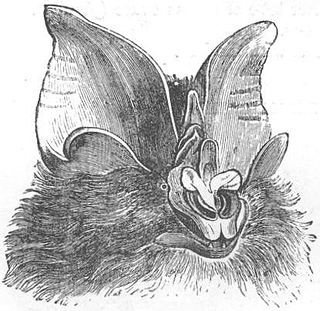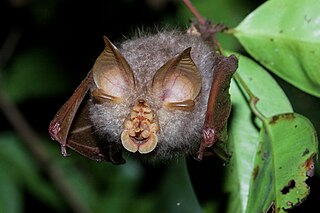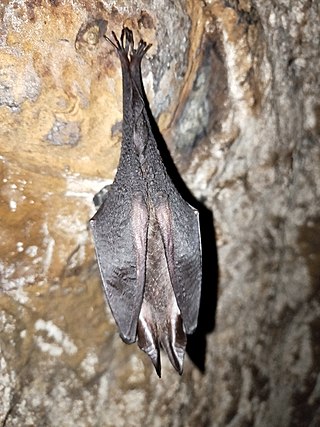
Horseshoe bats are bats in the family Rhinolophidae. In addition to the single living genus, Rhinolophus, which has about 106 species, the extinct genus Palaeonycteris has been recognized. Horseshoe bats are closely related to the Old World leaf-nosed bats, family Hipposideridae, which have sometimes been included in Rhinolophidae. The horseshoe bats are divided into six subgenera and many species groups. The most recent common ancestor of all horseshoe bats lived 34–40 million years ago, though it is unclear where the geographic roots of the family are, and attempts to determine its biogeography have been indecisive. Their taxonomy is complex, as genetic evidence shows the likely existence of many cryptic species, as well as species recognized as distinct that may have little genetic divergence from previously recognized taxa. They are found in the Old World, mostly in tropical or subtropical areas, including Africa, Asia, Europe, and Oceania.

The intermediate horseshoe bat is a bat species of the family Rhinolophidae that is very widespread throughout much of the Indian subcontinent, southern and central China and Southeast Asia. It is listed by IUCN as Least Concern as it is considered common where it occurs, without any known major threats.

The lesser woolly horseshoe bat, also called Beddome's horseshoe bat, is a species of bat in the family Rhinolophidae. It is found in India and Sri Lanka. Its natural habitats are subtropical or tropical moist lowland forests, caves, and urban areas.

The croslet horseshoe bat is a species of bat in the family Rhinolophidae. It is found in Laos, Malaysia, Myanmar, and Thailand.

The Andaman horseshoe bat is a species of bat in the family Rhinolophidae. It is endemic to the Andaman Islands. During the day, it roosts in caves, but may also choose tree hollows.

The convex horseshoe bat is a species of bat in the family Rhinolophidae. It is found in Malaysia and Laos.

Blyth's horseshoe bat is a species of bat in the family Rhinolophidae. It is found across southern Asia from Afghanistan to Vietnam. The species can be identified from its pointed, bifid sella.

The great woolly horseshoe bat is a species of bat in the family Rhinolophidae.

The big-eared horseshoe bat is a bat species within the Rhinolophidae native to Asia.

The lesser woolly horseshoe bat is a species of bat in the family Rhinolophidae. It is found in Brunei, Indonesia, and Malaysia. It is assessed as near-threatened by the IUCN.

The trefoil horseshoe bat is a species of bat in the family Rhinolophidae. It is found in Brunei, India, Indonesia, Malaysia, Myanmar, Singapore, and Thailand. In Borneo locally common up to 1,800m, including mangroves.

The Ziama horseshoe bat is a species of bat in the family Rhinolophidae. It was first described in 2002. It is found in Guinea, Sierra Leone, and Liberia. Its natural habitats are subtropical and tropical moist lowland and monstane forests. In 2013, Bat Conservation International listed this species as one of the 35 species of its worldwide priority list of conservation.

The Formosan woolly horseshoe bat is a species of bat from the family Rhinolophidae. It is endemic to Taiwan and occurs in primary forests in low to middle altitudes of central areas of Taiwan. Its roosting locations include caves, buildings, tunnels, and irrigation conduits. The species is listed as Least concern by the IUCN Red List, and it almost qualifies as a threatened species under criteria B1: extent of occurrence for geographic range. Its population is decreasing due to deforestation in Taiwanese lowlands, although it occurs in at least one protected area. The Formosan woolly horseshoe bat was formerly considered to be a subspecies of the woolly horseshoe bat, but is distinct.
The Bornean woolly horseshoe bat or Proconsul's horseshoe bat is an endangered species of horseshoe bat found on Borneo. Though it was discovered in 1959, it was not recognized as a distinct species until 2013.
The Sulawesi broad-eared horseshoe bat or Tatar horseshoe bat is a species of horseshoe bat found in Sulawesi, Indonesia.
Chiewkwee's horseshoe bat is a species of horseshoe bat endemic to the Malay Peninsula.
The Malaysian woolly horseshoe bat or Jester's horseshoe bat is a bat species of the family Rhinolophidae. It is found in the Malay Peninsula and northern Sumatra.
Francis's wooly horseshoe bat is a species of bat in the family Rhinolophidae found in Malaysia and Thailand. It was named in honor of Charles M. Francis.












